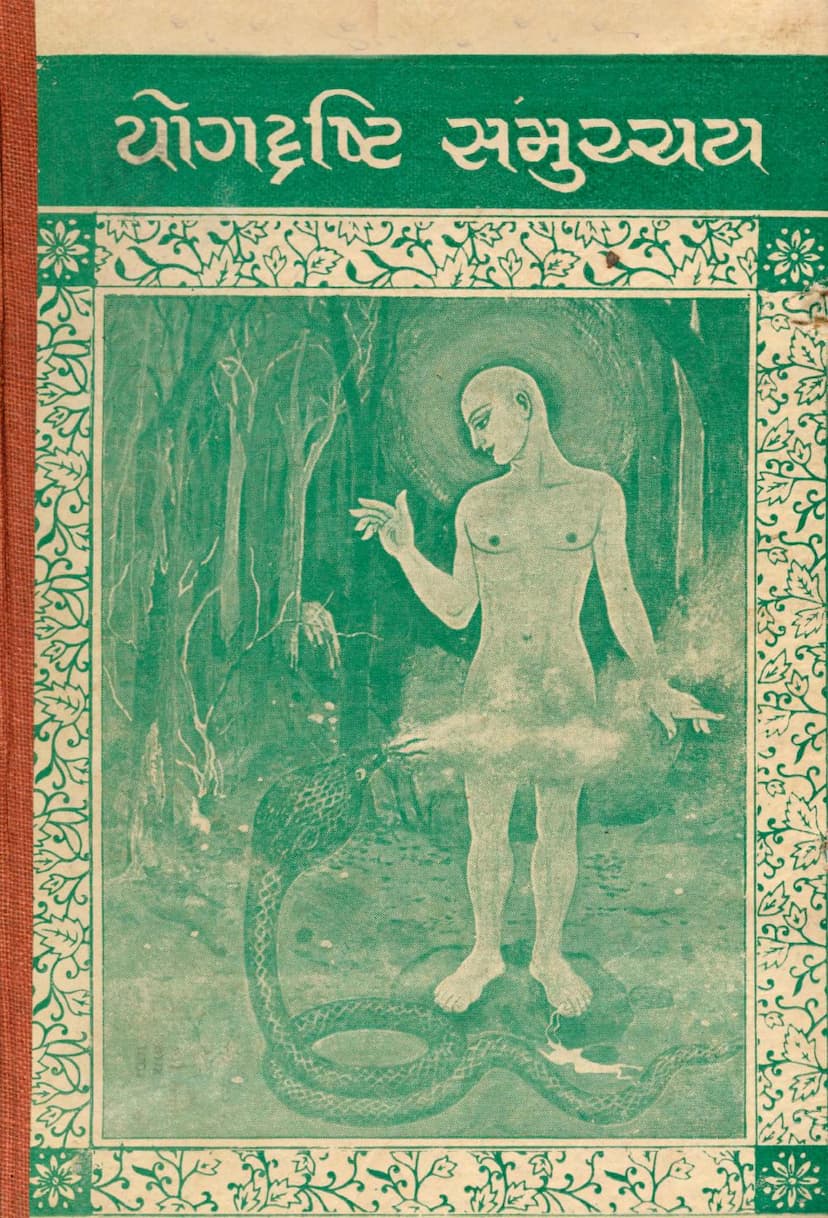Yogdrushti Samucchay
Added to library: September 2, 2025

Summary
This document is a collection of Jain philosophical and spiritual texts, primarily focused on the path of Yoga and self-realization, as prescribed within the Jain tradition. The core text appears to be "Yogdrushti Samucchay" (Collection of Yogic Perspectives) by Acharya Haribhadra Surishwarji Maharaj, with an editorial contribution by Vishvashanti Chahak. The publisher is Vishva Abhyuday Adhyatmik Granthmala.
Here's a breakdown of the key elements and themes present in the provided pages:
1. Title and Author:
- Book Title: Yogdrushti Samucchay (યોગદૃષ્ટિ સમુચ્ચય)
- Author: Acharya Haribhadra Surishwarji Maharaj (શ્રીમદ્ હરિભદ્ર સૂરીશ્વરજી મહારાજ)
- Editor/Compiler: Vishvashanti Chahak (વિશ્વશાન્તિ ચાહક)
- Publisher: Vishva Abhyuday Adhyatmik Granthmala (વિશ્વ અભ્યદય આધ્યાત્મિક ગ્રંથમાળા)
2. Core Message (from Page 2): The central advice given is for the soul (Jiva) to contemplate its pure, intelligent, and blissful nature. It emphasizes that by engaging with one's own soul, spiritual happiness can be attained. There is no other way to achieve infinite bliss than through self-knowledge. The yogi is exhorted to focus solely on their own soul and cultivate inner contemplation.
3. Key Concepts and Themes:
- Self-Realization and Spiritual Bliss: The primary goal is to realize the true nature of the soul, which is described as pure, intelligent, and blissful. This self-knowledge is presented as the sole path to achieving infinite happiness.
- Yoga and Meditation: The title itself, "Yogdrushti Samucchay," indicates a focus on the path of Yoga and the different perspectives or stages within it. The text delves into various aspects of yogic practice, including the "yogic eyes" or states of vision.
- Importance of Inner Contemplation: The text repeatedly stresses the need to turn inward and focus on the self, rather than external pursuits.
- Purification (Physical and Mental): Before self-realization, it is stated that physical and mental purification are necessary steps.
- Control of Desires and Attachment: The text highlights that the pursuit of pleasure and enjoyment hinders true peace. It reminds the reader that life is not meant for sensory pleasure or attachment to material objects, but for strengthening the mind and achieving self-purification.
- The Power of Bhavas (Emotions/States of Mind): Page 5 illustrates the immense power of emotional states through the story of Chandrakoshiya, a sage who became a serpent due to anger but achieved divinity through equanimity (Samata). This emphasizes that one's internal state determines their destiny.
- Stages of Spiritual Progress (Guna Sthana): Pages 13 and 14 present a detailed chart illustrating the progression through various stages of spiritual development (Gun Sthana) from the state of ignorance (Bahiratmā Bhava) to the highest state of perfection (Paramatmā Bhava). This progression is linked to different yogic practices like Asana, Pranayama, Pratyahara, Dharana, Dhyana, and Samadhi, and the increasing luminosity of consciousness.
- Overcoming Suffering: Page 15 discusses suffering, attributing it to one's own desires (vasanas). It advocates for identifying and eradicating these desires to eliminate suffering. The text also likens negative thoughts to falling into a well and emphasizes the need for a strong desire to stop them.
- The Eight Stages of Yoga (Ashtanga Yoga): The text details the eight limbs of Yoga: Yama, Niyama, Asana, Pranayama, Pratyahara, Dharana, Dhyana, and Samadhi. These are presented as crucial for spiritual progress, with different stages of "Drishti" (vision/perspective) corresponding to the mastery of these limbs.
- The Eight "Drishtis" (Perspectives/Stages): Pages 34-40 describe eight distinct stages or levels of spiritual vision: Mitrā (Friend), Tārah (Star), Balā (Strong), Dīprā (Luminous), Sthirā (Steady), Kāntā (Lovely), Prabhā (Radiant), and Parā (Supreme). Each stage is characterized by progress in yogic practices and the overcoming of mental obstacles. The distinction between "Oghdrushti" (common/mundane vision) and "Yogdrushti" (yogic vision) is made, highlighting the latter's progressive nature.
- Importance of the Guru and Right Conduct: The text stresses the role of a Guru and the importance of adherence to righteous conduct, ethical principles, and disciplined practice.
- Destruction of Karmas: The ultimate goal is liberation from the cycle of birth and death by shedding all karmas. The stages described are pathways to this liberation.
- Biographical Notes: Pages 7-11 contain brief biographical information about Shri Dalpatrambhai Jataashankar Vora and his family, likely included as a dedication or homage, highlighting their virtuous lives and spiritual leanings.
4. Structure and Presentation: The book appears to be a commentary or elaboration on the original work by Haribhadra Suri. It includes introductory materials, the core teachings, explanations of yogic concepts, illustrative stories (like Chandrakoshiya), and a philosophical framework for spiritual advancement. The language is devotional and instructional, aiming to guide the aspirant towards self-realization.
5. Associated Texts: The catalog link suggests this publication might also include or be related to "Ishtopadesh," "Samadhishtak," and "Atma Bodhakar Bhavana." Pages 153-181 of the provided text contain excerpts from "Ishtopadesh" and "Samadhi Shatak," and the entire "Atma Bodh" section, which further elaborates on self-awareness and spiritual principles.
In essence, "Yogdrushti Samucchay" is a comprehensive Jain guide to Yoga, emphasizing introspection, detachment, and the gradual stages of spiritual development leading to the ultimate goal of liberation and infinite bliss, attained through self-knowledge and disciplined practice.